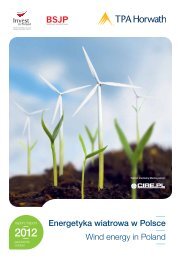Energetyka wiatrowa w Polsce Wind energy in Poland - TPA Horwath
Energetyka wiatrowa w Polsce Wind energy in Poland - TPA Horwath
Energetyka wiatrowa w Polsce Wind energy in Poland - TPA Horwath
Create successful ePaper yourself
Turn your PDF publications into a flip-book with our unique Google optimized e-Paper software.
8<br />
8.1<br />
8.2<br />
Rentowność projektów wiatrowych <strong>W<strong>in</strong>d</strong> project profitability<br />
Rentowność projektów wiatrowych<br />
<strong>W<strong>in</strong>d</strong> project profitability<br />
Liczba <strong>in</strong>westycji w farmy wiatrowe w <strong>Polsce</strong>, z roku na<br />
rok rośnie co oznacza, że dotychczas warunki rozwoju<br />
tego sektora były atrakcyjne. Na koniec pierwszego<br />
półrocza 2012 roku, funkcjonowało 619 koncesjonowanych<br />
<strong>in</strong>stalacji wiatrowych o łącznej za<strong>in</strong>stalowanej<br />
mocy 2 188,94 MW 34 . Oznacza to wzrost za<strong>in</strong>stalowanej<br />
mocy o nieco ponad 35% w porównaniu do roku 2011<br />
i aż o 58% w porównaniu do analogicznego okresu<br />
2011 roku. Aż 44% za<strong>in</strong>stalowanej mocy w <strong>Polsce</strong><br />
zlokalizowane jest w województwach zachodniopomorskim<br />
oraz pomorskim. Duża popularność <strong>in</strong>westycji<br />
wiatrowych w ostatnich latach wynikała głównie<br />
z faktu postrzegania ich jako relatywnie stabilnej lokaty<br />
kapitału ze stosunkowo wysoką stopą zwrotu. Niestety,<br />
planowane zmiany w polityce klimatycznej Unii Europejskiej<br />
oraz polskim prawie energetycznym mogą<br />
spowodować, iż sytuacja w branży energetyki wiatrowej<br />
diametralnie się zmieni. W świetle przyszłych zmian<br />
regulacji dotyczących systemów wsparcia, opisanych<br />
w punkcie 7 rozdz. 2, prognozowanie opłacalności<br />
projektów wiatrowych staje się szczególnie trudne,<br />
a niepewność w zakresie oceny rentowności projektów<br />
wiatrowych przekłada się na tymczasowe wstrzymanie<br />
nowych <strong>in</strong>westycji i odpływ <strong>in</strong>westorów.<br />
Nakłady <strong>in</strong>westycyjne<br />
Investment expenditures<br />
Farmy wiatrowe są <strong>in</strong>westycjami wysoce kapitałochłonnymi,<br />
w związku z czym koszty rozwoju <strong>in</strong>westycji<br />
są jednym z kluczowych elementów analizy<br />
rentowności przedsięwzięcia. Wysokie nakłady<br />
rekompensowane są stosunkowo niskimi rocznymi<br />
kosztami eksploatacji farmy wiatrowej, które stanowią<br />
ok. 3-4% kosztów <strong>in</strong>westycyjnych (w skali roku).<br />
Z analizy danych rynkowych wynika, iż przeciętne<br />
nakłady <strong>in</strong>westycyjne farm prowadzących działalność<br />
operacyjną kształtowały się na poziomie 6,0 mln zł<br />
w przeliczeniu na 1 MW mocy, natomiast przeciętne<br />
planowane nakłady farm będących w fazie rozwoju<br />
kształtują się na poziomie 6,6 mln zł na 1 MW. Należy<br />
pamiętać, że w zależności od wykorzystanych technologii<br />
czy wyboru lokalizacji farmy wiatrowej wartości<br />
te mogą się wahać od 4,4 mln aż do 8 mln zł za 1 MW<br />
mocy. Poniższy wykres prezentuje strukturę nakładów<br />
<strong>in</strong>westycyjnych w oparciu o dane rynkowe wybranych<br />
projektów wiatrowych.<br />
Zdecydowaną większość ogólnych nakładów <strong>in</strong>westycyjnych<br />
pochłaniają turb<strong>in</strong>y wiatrowe. W ostatnich<br />
34 www.ure.gov.pl<br />
The number of <strong>in</strong>vestments <strong>in</strong> w<strong>in</strong>d farms <strong>in</strong> <strong>Poland</strong> has<br />
been <strong>in</strong>creas<strong>in</strong>g from year to year, which means that,<br />
so far, this sector has enjoyed attractive conditions for<br />
development. At the end of the first half of 2012, there<br />
were 619 licensed w<strong>in</strong>d <strong>in</strong>stallations <strong>in</strong> operation, with<br />
aggregate <strong>in</strong>stalled capacity of 2,188.94MW 34 . This<br />
means a rise <strong>in</strong> <strong>in</strong>stalled capacity of slightly more than<br />
35 percent compared to 2011 and a healthy 58-percent<br />
rise compared to the respective period of 2011. As<br />
much as 44 percent of the <strong>in</strong>stalled capacity <strong>in</strong> <strong>Poland</strong><br />
is located with<strong>in</strong> the prov<strong>in</strong>ces of Zachodniopomorskie<br />
and Pomorskie. The great popularity of w<strong>in</strong>d <strong>in</strong>vestments<br />
<strong>in</strong> recent years resulted ma<strong>in</strong>ly from them be<strong>in</strong>g<br />
seen as a relatively stable form of capital <strong>in</strong>vestment<br />
with a relatively high rate of return. Unfortunately, the<br />
changes planned to the European Union climate policy<br />
as well as Polish <strong>energy</strong> law, may entail far-reach<strong>in</strong>g<br />
consequences for the w<strong>in</strong>d <strong>energy</strong> sector. In the view of<br />
the future changes to the regulations on support systems<br />
described <strong>in</strong> po<strong>in</strong>t 7 part 2, forecast<strong>in</strong>g profitability of<br />
w<strong>in</strong>d projects has become particularly difficult, and such<br />
uncerta<strong>in</strong>ty <strong>in</strong> profitability assessment of w<strong>in</strong>d projects<br />
translates <strong>in</strong>to a temporary freez<strong>in</strong>g of new <strong>in</strong>vestments<br />
as well as <strong>in</strong>vestor withdrawal.<br />
<strong>W<strong>in</strong>d</strong> farms are a highly capital <strong>in</strong>tensive type of<br />
<strong>in</strong>vestment, which makes the development costs one<br />
of the key elements of bus<strong>in</strong>ess profitability analysis.<br />
High capital expenditures are offset by relatively low<br />
yearly operat<strong>in</strong>g costs of a w<strong>in</strong>d farm, account<strong>in</strong>g for ca.<br />
3-4 percent of the yearly <strong>in</strong>vestment costs. Market data<br />
analysis shows that average <strong>in</strong>vestment expenditures<br />
for w<strong>in</strong>d farms <strong>in</strong> operation stood at 6.0 million PLN per<br />
1 MW of capacity whereas average planned <strong>in</strong>vestment<br />
expenditures for farms <strong>in</strong> development equalled<br />
6.6 million PLN per 1MW. One should bear <strong>in</strong> m<strong>in</strong>d<br />
that, depend<strong>in</strong>g on the type of technology applied or<br />
the location site chosen for a w<strong>in</strong>d farm, these values<br />
can oscillate between 4.4 million and the high level of<br />
8.0 million PLN per 1MW. The chart below presents<br />
the structure of <strong>in</strong>vestment expenditures <strong>in</strong> w<strong>in</strong>d farm<br />
projects, based on market data for specific projects.<br />
An overwhelm<strong>in</strong>g percentage of total <strong>in</strong>vestment<br />
expenditures is taken up by w<strong>in</strong>d turb<strong>in</strong>es. In recent<br />
years, there has been a moderate decl<strong>in</strong>e <strong>in</strong> their share<br />
<strong>in</strong> the overall structure of expenditures. Market data<br />
34 www.ure.gov.pl<br />
<strong>Energetyka</strong> <strong>wiatrowa</strong> w <strong>Polsce</strong> / <strong>W<strong>in</strong>d</strong> <strong>energy</strong> <strong>in</strong> <strong>Poland</strong><br />
69



